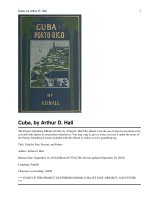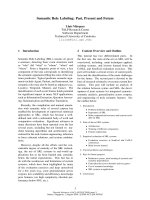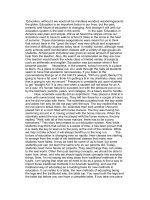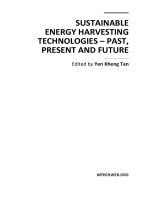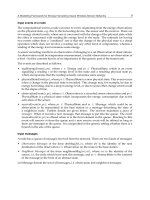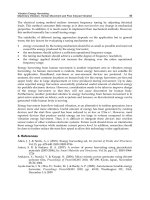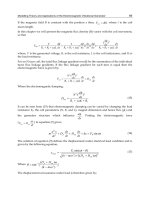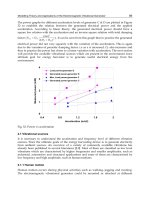Tangible User Interfaces: Past, Present, and Future Directions ppsx
Bạn đang xem bản rút gọn của tài liệu. Xem và tải ngay bản đầy đủ của tài liệu tại đây (4.36 MB, 140 trang )
Foundations and Trends
R
in
Human–Computer Interaction
Vol. 3, Nos. 1–2 (2009) 1–137
c
2010 O. Shaer and E. Hornecker
DOI: 10.1561/1100000026
Tangible User Interfaces: Past, Present, and
Future Directions
By Orit Shaer and Eva Hornecker
Contents
1 Introduction 3
2 Origins of Tangible User Interfaces 6
2.1 Graspable User Interface 7
2.2 Tangible Bits 8
2.3 Precursors of Tangible User Interfaces 10
3 Tangible Interfaces in a Broader Context 14
3.1 Related Research Areas 14
3.2 Unifying Perspectives 17
3.3 Reality-Based Interaction 19
4 Application Domains 22
4.1 TUIs for Learning 23
4.2 Problem Solving and Planning 27
4.3 Information Visualization 31
4.4 Tangible Programming 33
4.5 Entertainment, Play, and Edutainment 36
4.6 Music and Performance 39
4.7 Social Communication 43
4.8 Tangible Reminders and Tags 44
5 Frameworks and Taxonomies 46
5.1 Properties of Graspable User Interfaces 47
5.2 Conceptualization of TUIs and the MCRit
Interaction Model 48
5.3 Classifications of TUIs 49
5.4 Frameworks on Mappings: Coupling the Physical
with the Digital 51
5.5 Tokens and Constraints 54
5.6 Frameworks for Tangible and Sensor-Based Interaction 56
5.7 Domain-Specific Frameworks 59
6 Conceptual Foundations 62
6.1 Cuing Interaction: Affordances, Constraints, Mappings
and Image Schemas 62
6.2 Embodiment and Phenomenology 64
6.3 External Representation and Distributed Cognition 66
6.4 Two-Handed Interaction 69
6.5 Semiotics 70
7 Implementation Technologies 73
7.1 RFID 74
7.2 Computer Vision 75
7.3 Microcontrollers, Sensors, and Actuators 77
7.4 Comparison of Implementation Technologies 79
7.5 Tool Support for Tangible Interaction 81
8 Design and Evaluation Methods 88
8.1 Design and Implementation 88
8.2 Evaluation 93
9 Strengths and Limitations of
Tangible User Interfaces 96
9.1 Strengths 97
9.2 Limitations 105
10 Research Directions 109
10.1 Actuation 109
10.2 From Tangible User Interfaces to Organic User Interfaces 111
10.3 From Tangible Representation to Tangible Resources for
Action 112
10.4 Whole-Body Interaction and Performative Tangible
Interaction 114
10.5 Aesthetics 115
10.6 Long-Term Interaction Studies 115
11 Summary 118
Acknowledgments 120
References 121
Foundations and Trends
R
in
Human–Computer Interaction
Vol. 3, Nos. 1–2 (2009) 1–137
c
2010 O. Shaer and E. Hornecker
DOI: 10.1561/1100000026
Tangible User Interfaces: Past, Present, and
Future Directions
Orit Shaer
1
and Eva Hornecker
2
1
Wellesley College, 106 Central St., Wellesley, MA, 02481, USA,
2
University of Strathclyde, 26 Richmond Street, Glasgow, Scotland,
G1 1XH, UK,
Abstract
In the last two decades, Tangible User Interfaces (TUIs) have emerged
as a new interface type that interlinks the digital and physical worlds.
Drawing upon users’ knowledge and skills of interaction with the real
non-digital world, TUIs show a potential to enhance the way in which
people interact with and leverage digital information. However, TUI
research is still in its infancy and extensive research is required in
order to fully understand the implications of tangible user interfaces,
to develop technologies that further bridge the digital and the physical,
and to guide TUI design with empirical knowledge.
This monograph examines the existing body of work on Tangible
User Interfaces. We start by sketching the history of tangible user inter-
faces, examining the intellectual origins of this field. We then present
TUIs in a broader context, survey application domains, and review
frameworks and taxonomies. We also discuss conceptual foundations
of TUIs including perspectives from cognitive sciences, psychology,
and philosophy. Methods and technologies for designing, building, and
evaluating TUIs are also addressed. Finally, we discuss the strengths
and limitations of TUIs and chart directions for future research.
1
Introduction
“We live in a complex world, filled with myriad objects,
tools, toys, and people. Our lives are spent in diverse
interaction with this environment. Yet, for the most
part, our computing takes place sitting in front of, and
staring at, a single glowing screen attached to an array
of buttons and a mouse.” [253]
For a long time, it seemed as if the human–computer interface was to
be limited to working on a desktop computer, using a mouse and a key-
board to interact with windows, icons, menus, and pointers (WIMP).
While the detailed design was being refined with ever more polished
graphics, WIMP interfaces seemed undisputed and no alternative inter-
action styles existed. For any application domain, from productivity
tools to games, the same generic input devices were employed.
Over the past two decades, human–computer interaction (HCI)
researchers have developed a wide range of interaction styles and inter-
faces that diverge from the WIMP interface. Technological advance-
ments and a better understanding of the psychological and social
aspects of HCI have lead to a recent explosion of new post-WIMP
3
4 Introduction
interaction styles. Novel input devices that draw on users’ skill of inter-
action with the real non-digital world gain increasing popularity (e.g.,
the Wii Remote controller, multi-touch surfaces). Simultaneously, an
invisible revolution takes place: computers become embedded in every-
day objects and environments, and products integrate computational
and mechatronic components,
This monograph provides a survey of the research on Tangible
User Interfaces (TUIs), an emerging post-WIMP interface type that
is concerned with providing tangible representations to digital infor-
mation and controls, allowing users to quite literally grasp data with
their hands. Implemented using a variety of technologies and materi-
als, TUIs computationally augment physical objects by coupling them
to digital data. Serving as direct, tangible representations of digital
information, these augmented physical objects often function as both
input and output devices providing users with parallel feedback loops:
physical, passive haptic feedback that informs users that a certain phys-
ical manipulation is complete; and digital, visual or auditory feedback
that informs users of the computational interpretation of their action
[237]. Interaction with TUIs is therefore not limited to the visual and
aural senses, but also relies on the sense of touch. Furthermore, TUIs
are not limited to two-dimensional images on a screen; interaction
can become three-dimensional. Because TUIs are an emerging field of
research, the design space of TUIs is constantly evolving. Thus, the
goal of this monograph is not to bound what a TUI is or is not. Rather,
it describes common characteristics of TUIs and discusses a range of
perspectives so as to provide readers with means for thinking about
particular designs.
Tangible Interfaces have an instant appeal to a broad range of users.
They draw upon the human urge to be active and creative with one’s
hands [257], and can provide a means to interact with computational
applications in ways that leverage users’ knowledge and skills of inter-
action with the everyday, non-digital, world [119].
TUIs have become an established research area through the con-
tributions of Hiroshi Ishii and his Tangible Media Group as well as
through the efforts of other research groups worldwide. The word ‘tan-
gible’ now appears in many calls for papers or conference session titles.
5
Following diverse workshops related to tangible interfaces at different
conferences, the first conference fully devoted to tangible interfaces and,
more generally, tangible interaction, took place in 2007 in Baton Rouge,
Louisiana. Since then, the annual TEI Conference (Tangible, Embedded
and Embodied Interaction) serves as a focal point for a diverse commu-
nity that consists of HCI researchers, technologists, product designers,
artists, and others.
This monograph is the result of a systematic review of the body of
work on tangible user interfaces. Our aim has been to provide a useful
and unbiased overview of history, research trends, intellectual lineages,
background theories, and technologies, and open research questions for
anyone who wants to start working in this area, be it in developing
systems or analyzing and evaluating them. We first surveyed seminal
work on tangible user interfaces to expose lines of intellectual influence.
Then, in order to clarify the scope of this monograph we examined
past TEI and CHI proceedings for emerging themes. We then identified
a set of questions to be answered by this monograph and conducted
dedicated literature research on each of these questions.
We begin by sketching the history of tangible user interfaces, tak-
ing a look at the origins of this field. We then discuss the broader
research context surrounding TUIs, which includes a range of related
research areas. Section 4 is devoted to an overview of dominant appli-
cation areas of TUIs. Section 5 provides an overview of frameworks and
theoretical work in the field, discussing attempts to conceptualize, cat-
egorize, analyze, and describe TUIs, as well as analytical approaches to
understand issues of TUI interaction. We then present conceptual foun-
dations underlying the ideas of TUIs in Section 6. Section 7 provides
an overview of implementation technologies and toolkits for building
TUIs. We then move on to design and evaluation methods in Section 8.
We close with a discussion of the strengths and limitations of TUIs and
future research directions.
2
Origins of Tangible User Interfaces
The development of the notion of a “tangible interface” is closely tied
to the initial motivation for Augmented Reality and Ubiquitous Com-
puting. In 1993, a special issue of the Communications of the ACM
titled “Back to the Real World” [253] argued that both desktop com-
puters and virtual reality estrange humans from their “natural environ-
ment”. The issue suggested that rather than forcing users to enter a
virtual world, one should augment and enrich the real world with digital
functionality. This approach was motivated by the desire to retain the
richness and situatedness of physical interaction, and by the attempt
to embed computing in existing environments and human practices to
enable fluid transitions between “the digital” and “the real”. Ideas from
ethnography, situated cognition, and phenomenology became influen-
tial in the argumentation for Augmented Reality and Ubiquitous Com-
puting: “humans are of and in the everyday world” [251]. Tangible
Interfaces emerged as part of this trend.
While underlying ideas for tangible user interfaces had been
discussed in the “Back to the Real World” special issue, it took a
few years for these ideas to evolve into an interaction style in its
own right. In 1995, Fitzmaurice et al. [67] introduced the notion of
a Graspable Interface, where graspable handles are used to manipu-
late digital objects. Ishii and his students [117] presented the more
6
2.1 Graspable User Interface 7
comprehensive vision of Tangible Bits in 1997. Their vision centered
on turning the physical world into an interface by connecting objects
and surfaces with digital data. Based on this work, the tangible user
interface has emerged as a new interface and interaction style.
While Ishii and his students developed a rich research agenda to fur-
ther investigate their Tangible Bits vision, other research teams focused
on specific application domains and the support of established work
practices through the augmentation of existing media and artifacts.
Such efforts often resulted in systems that can also be classified as Tan-
gible Interfaces. Particularly notable is the work of Wendy Mackay on
the use of flight strips in air traffic control and on augmented paper in
video storyboarding [150]. Similar ideas were developed simultaneously
worldwide, indicating a felt need for a countermovement to the increas-
ing digitization and virtualization. Examples include the German Real
Reality approach for simultaneous building of real and digital models
[24, 25], and the work of Rauterberg and his group in Switzerland.
The latter extended Fitzmaurice’s graspable interface idea and devel-
oped Build-IT, an augmented reality tabletop planning tool that is
interacted via the principle of graspable handles. In Japan, Suzuki and
Kato [230, 231] developed AlgoBlocks to support groups of children in
learning to program. Cohen et al. [41] developed Logjam to support
video logging and coding.
For most of the decade following the proposition of TUIs as a novel
interface style, research focused on developing systems that explore
technical possibilities. In recent years, this proof-of-concept phase has
led on to a more mature stage of research with increased emphasis on
conceptual design, user and field tests, critical reflection, theory, and
building of design knowledge. Connections with related developments
in the design disciplines became stronger, especially since a range of
toolkits have become available which considerably lower the threshold
for developing TUIs.
2.1 Graspable User Interface
In 1995, Fitzmaurice et al. [67] introduced the concept of a Graspable
Interface, using wooden blocks as graspable handles to manipulate
8 Origins of Tangible User Interfaces
digital objects. Their aim was to increase the directness and manipu-
lability of graphical user interfaces. A block is anchored to a graphical
object on the monitor by placing it on top of it. Moving and rotating
the block has the graphic object moving in synchrony. Placing two
blocks on two corners of an object activates a zoom as the two corners
will be dragged along with the blocks. This allowed for the kinds
of two-handed or two-fingered interactions that we nowadays know
from multi-touch surfaces. A further focus was the use of functionally
dedicated input tools.
Graspable handles in combination with functionally dedicated input
tools were argued to distribute input in space instead of time, effec-
tively de-sequentializing interaction, to support bimanual action and
to reduce the mediation between input devices and interaction objects.
A system that directly builds on this idea is Rauterberg’s Build-IT [69].
This utilizes said input mechanisms in combination with Aug-
mented Reality visualizations for architectural and factory planning
tasks.
2.2 Tangible Bits
Only a few years later, Hiroshi Ishii and his students introduced the
notion of Tangible Bits which soon led to proposition of a Tangible
User Interface [117]. The aim was to make bits directly accessible and
manipulable, using the real world as a display and as medium for
manipulation – the entire world could become an interface. Data could
be connected with physical artifacts and architectonic surfaces, making
bits tangible. Ambient displays on the other hand would represent
information through sound, lights, air, or water movement. The
artwork of Natalie Jeremijenko, in particular LiveWire, a dangling,
dancing string hanging from the ceiling with its movement visualizing
network and website traffic served as an inspiration for the concept of
ambient displays.
The change of term from graspable to tangible seems deliberate.
Whereas “graspable” emphasizes the ability to manually manipulate
objects, the meaning of “tangible” encompasses “realness/sureness”,
being able to be touched as well as the action of touching, which
2.2 Tangible Bits 9
includes multisensory perception:
“GUIs fall short of embracing the richness of human
senses and skills people have developed through a life-
time of interaction with the physical world. Our attempt
is to change ‘painted bits’ into ‘tangible bits’ by taking
advantage of multiple senses and the multimodality of
human interactions with the real world. We believe the
use of graspable objects and ambient media will lead
us to a much richer multi-sensory experience of digital
information.” [117]
Ishii’s work focused on using tangible objects to both manipulate
and represent digital content. One of the first TUI prototypes was Tan-
gible Geospace, an interactive map of the MIT Campus on a projection
table. Placing physical icons onto the table, e.g., a plexiglas model of
the MIT dome, had the map reposition itself so that the model was
positioned over the respective building on the map. Adding another
tangible model made the map zoom and turn to match the buildings.
Small movable monitors served as a magic lens showing a 3D repre-
sentation of the underlying area. These interfaces built on the gras-
pable interface’s interaction principle of bimanual direct manipulation,
but replaced its abstract and generic blocks with iconic and symbolic
stand-ins.
Still, the first TUI prototypes were influenced strongly from GUI-
metaphors. Later projects such as Urp [241] intentionally aimed to
divert from GUI-like interaction, focusing on graspable tokens that
serve for manipulating as well as representing data. Urp supports urban
planning processes (see Figure 2.1). It enables users to interact with
wind flow and sunlight simulations through the placement of physical
building models and tools upon a surface. The tangible building models
cast (digital) shadows that are projected onto the surface. Simulated
wind flow is projected as lines onto the surface. Several tangible tools
enable users to control and alter the urban model. For example, users
can probe the wind speed or distances, change the material properties
of buildings (glass or stone walls), and change the time of day. Such
10 Origins of Tangible User Interfaces
Fig. 2.1 Urp [241], a TUI for urban planning that combines physical models with interactive
simualation. Projections show the flow of wind, and a wind probe (the circular object) is
used to investigate wind speed (photo: by E. Hornecker).
changes affect the digital shadows that are projected and the wind
simulation.
2.3 Precursors of Tangible User Interfaces
Several precursors to the work of Ishii and his students have influenced
the field. These addressed issues in specific application domains such
as architecture, product design, and educational technology. The ideas
introduced by these systems later inspired HCI researchers in their
pursuit to develop new interface and interaction concepts.
2.3.1 The Slot Machine
Probably the first system that can be classified as a tangible interface
was Perlman’s Slot Machine [185]. The Slot Machine uses physical cards
to represent language constructs that are used to program the Logo
Turtle (see also [161]). Seymour Papert’s research had shown that while
the physical turtle robot helped children to understand how geometric
2.3 Precursors of Tangible User Interfaces 11
forms are created in space, writing programs was difficult for younger
children and impossible for preschoolers who could not type. Perlman
believed that these difficulties result not only from the language syn-
tax, but also from the user interface. Her first prototype consisted of a
box with a set of buttons that allowed devising simple programs from
actions and numbers. The box then was used as a remote control for the
turtle. This device could also record and replay the turtle movement,
providing a programming-by-demonstration mode. Her final prototype
was the Slot Machine, which allowed modifying programs and proce-
dure calls.
In the Slot Machine, each programming language construct (an
action, number, variable, or condition) is represented by a plastic card.
To specify a program, sequences of cards are inserted into one of three
differently colored racks on the machine. On the left of the rack is a
“Do It” button, that causes the turtle to execute the commands from
left to right. Stacking cards of different type onto each other creates
complex commands such as “move forward twice”. Placing a special
colored card in a rack invokes a procedure call for the respectively col-
ored rack that upon execution returns to the remainder of the rack.
This mechanism implements function calls as well as simple recursion.
2.3.2 The Marble Answering Machine
Often mentioned as inspiration for the development of tangible inter-
faces [117] are the works of product designer Durrell Bishop. During
his studies at the Royal College of Art, Bishop designed the Marble
Answering Machine as a concept sketch [1, 190]. In the Marble Answer-
ing Machine, incoming calls are represented with colored marbles that
roll into a bowl embedded in the machine (see Figure 2.2). Placed
into an indentation, the messages are played back. Putting a marble
onto an indentation on the phone calls the number from which the call
originated.
Bishop’s designs rely on physical affordances and users’ everyday
knowledge to communicate the functionality and the how to interact [1].
These ideas were very different to the dominant school of product design
in the 1990s, which employed product semantics primarily to influence
12 Origins of Tangible User Interfaces
Fig. 2.2 The Marble Answering Machine [1]. Left: new messages have arrived and the
user chooses to keepsake one to hear later. Right: the user plays back the selected message
(graphics by Yvonne Baier, reprinted from form+zweck No. 22 www.formundzweck.de).
Fig. 2.3 Frazer and Frazer [71] envisioned an intelligent 3D modeling system that creates
a virtual model from tangible manipulation (graphic courtesy: John Frazer).
users’ emotions and associations. Most striking is how Bishop’s works
assign new meanings to objects (object mapping), turning them into
pointers to something else, into containers for data and references to
other objects in a network. Many of his designs further employ spatial
mappings, deriving meaning from the context of an action (e.g., its
place). Bishop’s designs use known objects as legible references to the
aesthetics of new electronic projects, yet they refrain from simplistic lit-
eral metaphors. Playfully recombining meanings and actions, Bishop’s
designs have remained a challenge and inspiration.
2.3.3 Intelligent 3D Modeling
In the early 1980s, independently of each other, both Robert Aish
[3, 4] and the team around John Frazer [70, 71, 72] were looking for
2.3 Precursors of Tangible User Interfaces 13
alternatives to architectural CAD systems which at that time were
clunky and cumbersome. These two groups were motivated by simi-
lar ideas. They sought to enable the future inhabitants of buildings to
partake in design discussions with architects, to simplify the “man–
machine dialog” with CAD, and to support rapid idea testing.
Thus, both came up with the idea of using physical models as input
devices for CAD systems. Aish described his approach in 1979 [3], argu-
ing that numerical CAD-modeling languages discourage rapid testing
and alteration of ideas. Frazer was then first to build a working proto-
type, demoed live at the Computer Graphics conference in 1980. Aish
and Frazer both developed systems for “3D modelling” where users
build a physical model from provided blocks. The computer then inter-
rogates or scans the assembly, deduces location, orientation and type
of each component, and creates a digital model. Users can configure
the digital properties of blocks and let the computer perform calcu-
lations such as floor space, water piping, or energy consumption. The
underlying computer simulation could also provide suggestions on how
to improve the design. Once the user is satisfied, the machine can pro-
duce the plans and working drawings.
Frazer’s team (for an overview see [70]) experimented with a variety
of application areas and systems, some based on components that could
be plugged onto a 2D grid, others based on building blocks that could
be connected to 3D structures. The blocks had internal circuitry, being
able to scan its connections, poll its neighbours, and to pass messages.
By 1982 the system was miniaturized to bricks smaller than two sugar
cubes. Aish, on the other hand, experimented with a truly bi-directional
human–machine dialog [4], using a robot to execute the computer’s
suggestions for changing the physical model.
3
Tangible Interfaces in a Broader Context
In this section, we survey research areas that are related to and overlap
with TUIs. We also discuss literature that interprets TUIs as part of an
emerging generation of HCI, or a larger research endeavor. We begin by
describing the fields of Tangible Augmented Reality, Tangible Table-
top Interaction, Ambient displays, and Embodied Interaction. We then
discuss unifying perspectives such as Tangible Computing, Tangible
Interaction, and Reality-Based Interaction.
3.1 Related Research Areas
Various technological approaches in the area of next generation
user interfaces have been influencing each other, resulting in mixed
approaches that combine different ideas or interaction mechanisms.
Some approaches, such as ambient displays, were originally conceived as
part of the Tangible Bits vision, others can be considered a specialized
type of TUI or as sharing characteristics with TUIs.
3.1.1 Tangible Augmented Reality
Tangible Augmented Reality (Tangible AR) interfaces [132, 148, 263]
combine tangible input with an augmented reality display or output.
14
3.1 Related Research Areas 15
The virtual objects are “attached” to physical objects that the user
manipulates. A 3D-visualization of the virtual object is overlaid onto
the physical manipulative which is tagged with a visual marker
(detectable with computer vision). The digital imagery becomes vis-
ible through a display, often in the form of see-through glasses, a magic
lens, or an augmented mirror. Such a display typically shows a video
image where the digital imagery is inserted at the same location and
3D orientation as the visual marker. Examples of this approach include
augmented books [18, 263] and tangible tiles [148].
3.1.2 Tangible Tabletop Interaction
Tangible tabletop interaction combines interaction techniques and tech-
nologies of interactive multi-touch surfaces and TUIs. Many tangible
interfaces use a tabletop surface as base for interaction, embedding the
tracking mechanism in the surface. With the advancement in interac-
tive and multi-touch surfaces the terminology has become more specific,
tabletop interaction referring predominantly to finger-touch or pen-
based interaction. But simultaneously, studies within the research area
of interactive surfaces increasingly investigate mixed technologies [135],
typically utilizing a few dedicated tangible input devices and artifacts
on a multi-touch table. Research in this field is starting to investi-
gate the differences between pure touch-based interaction and tangible
handles (e.g., [232]) and to develop new techniques for optical object
sensing through the surface (e.g., [118]). Toolkits such as reacTIVi-
sion [125] enable a blend of tangible input and multi-touch, the most
prominent example being the reacTable [125], a tool for computer music
performers.
3.1.3 Ambient Displays
Ambient displays were originally a part of Ishii’s Tangible Bits vision
[117], but soon developed into a research area of its own, many ambient
displays being based on purely graphical representations on monitors
and wall displays. The first example of an ambient display with a phys-
ical world realization is likely Jerimijenko’s LiveWire.
16 Tangible Interfaces in a Broader Context
Greenberg and Fitchett [82] describe a range of student projects
that used the Phidgets toolkit to build physical awareness devices, for
example, a flower that blooms to convey the availability of a work
colleague. The active-Hydra project [83] introduced a backchannel,
where user’s proximity to and handling of a figurine affect the fidelity
of audio and video in a media window (an always-on teleconference).
Some more recent projects employ tangible interfaces as ambient dis-
plays. Many support distributed groups in maintaining awareness [23],
using physical artifacts for input as well as output. Commercial applica-
tions include the Nabaztag bunnies, which in response to digital events
received via a network connection blink and move their ears. Edge and
Blackwell [51] suggest that tangible objects can drift between focus and
periphery of a user’s attention and present an example of peripheral
(and thus ambient) interaction with tangibles. Here tangible objects
on a surface next to an office worker’s workspace represent tasks and
documents, supporting personal and group task management and coor-
dination.
3.1.4 Embodied User Interfaces
The idea of embodied user interfaces [54, 64] acknowledges that com-
putation is becoming embedded and embodied in physical devices and
appliances. The manual interaction with a device can thus become an
integral part of using an integrated physical–virtual device, using its
body as part of the interface:
“So, why can’t users manipulate devices in a variety of
ways - squeeze, shake, flick, tilt - as an integral part of
using them? ( ) We want to take user interface design
a step further by more tightly integrating the physical
body of the device with the virtual contents inside and
the graphical display of the content.” [64]
While research prototypes have been developed since 2000, only
with the iPhone has tilting a device become a standard interaction
technique, the display changing orientation accordingly. While con-
ceived of as an interface vision of its own, the direct embodiment of
3.2 Unifying Perspectives 17
Fig. 3.1 Research areas related to TUIs. From left to right: Tangible Augmented Reality,
virtual objects (e.g., airplane) are “attached” to physically manipulated objects (e.g., card);
Tangible Tabletop Interaction, physical objects are manipulated upon a multi-touch surface;
Ambient Displays, physical objects are used as ambient displays; Embodied User Interfaces,
physical devices are integrated with their digital content.
computational functionality can be considered a specialized type of
tangible interface where there is only one physical input object (which
may have different parts that can be manipulated).
3.2 Unifying Perspectives
3.2.1 Tangible Computing
Dourish [50] discusses multiple concepts that are based on the idea
of integrating computation into our everyday world under the term
tangible computing. These concepts include TUIs, Ubiquitous Comput-
ing, Augmented Reality, Reactive Rooms, and Context-Aware Devices.
Tangible Computing covers three trends: distributing computation over
many specialized and networked devices in the environment, augment-
ing the everyday world computationally so that it is able to react to the
user, and enabling users to interact by manipulating physical objects.
The concepts share three characteristics [50]:
•
no single locus of control or interaction. Instead of just one
input device, there is a coordinated interplay of different
devices and objects;
•
no enforced sequentiality (order of actions) and no modal
interaction; and
•
the design of interface objects makes intentional use of affor-
dances which guide the user in how to interact.
18 Tangible Interfaces in a Broader Context
Embedding computation in the environment creates embodied inter-
action — it is socially and physically situated. As a core research ques-
tion Dourish [50] identifies the relation of actions with the space in
which they are performed. This refers to the configuration of the envi-
ronment effecting computational functionality, and the position and
orientation of the user being relevant for how actions are interpreted
(e.g., a device is activated if one walks toward it). The term tangible
computing emphasizes the material manifestation of the interface (this
is where tangible interfaces go the farthest) and the embedding of com-
puting in the environment.
Tangible Interfaces differ from the other approaches by making evi-
dent that representations are artifacts in their own right that the user
can directly act upon, lift up, rearrange, sort and manipulate [50]. In
particular, at one moment in time, several levels of meaning can be
present. Moving a prism token in Illuminating Light (a physics learn-
ing system that emulates a laser light installation with laser beams
and prisms on a surface) [240] can be done simply to make space, to
explore the system response, as moving the prism (seeing the token
as stand-in), as moving the laser beam (using the token as a tool),
or to manipulate the mathematical simulation underneath (the entire
system is a tool). The user can freely switch attention between these
different levels. This seamless nesting of levels is made possible through
the embodiment of computation.
3.2.2 Tangible Interaction
Hornecker and Buur [105] suggest the term tangible interaction to
describe a field of approaches related to, but broader than TUIs. They
argue that many systems developed within arts and design aimed at
creating rich physical interactions share characteristics with TUIs. But
the definitions used to describe tangible user interfaces are too restric-
tive for these related areas. Instead of focusing on providing tangible
“handles” (physical pointers) to support the manipulation of digital
data, many of these related systems aim at controlling things in the
real world (e.g., a heating controller) or at enabling rich or skilled bod-
ily interaction [29]. In the latter case the emphasis lies more on the
3.3 Reality-Based Interaction 19
expressiveness and meaning of bodily movement and less on the phys-
ical device employed in generating this movement or the “data” being
manipulated.
The tangible interface definition “using physical objects to rep-
resent and manipulate digital data” is identified as a data-centered
view because this phrasing indicates that data is the starting point for
design. The expressive-movement view, in contrast, focuses on bodily
movement, rich expression and physical skill, and starts design by
thinking about the interactions and actions involved. In the arts, a
space-centered view is more dominant, emphasizing interactive and
reactive spaces where computing and tangible elements are means to
an end and the spectator’s body movement can become an integral
part of an art installation. Interaction designers have also developed an
interest in bodily interaction, which can be pure movement (gestures,
dance) or is related to physical objects.
Tangible Interaction adopts a terminology preferred by the design
community, which focuses on the user experience and interaction with a
system [14, 243]. As an encompassing perspective it emphasizes tangi-
bility and materiality, physical embodiment of data, bodily interaction,
and the embedding of systems in real spaces and contexts. This embed-
dedness is why tangible interaction is always situated in physical and
social contexts (cf. [50]).
3.3 Reality-Based Interaction
Jacob et al. [119] proposed the notion of reality-based interaction as a
unifying framework that ties together a large subset of emerging inter-
action styles and views them as a new generation of HCI. This notion
encompasses a broad range of interaction styles including virtual real-
ity, augmented reality, ubiquitous and pervasive computing, handheld
interaction, and tangible interaction [119].
The term reality-based interaction results from the observation that
many new interaction styles are designed to take advantage of users’
well-entrenched skills and experience of interacting with the real non-
digital world to a greater extent than before. That is, interaction with
digital information becomes more like interaction with the real world.
20 Tangible Interfaces in a Broader Context
Fig. 3.2 Four themes of reality-based interaction [119].
Furthermore, emerging interaction styles transform interaction from
a segregated activity that takes place at a desk to a fluid free form
activity that takes place within the non-digital environment. Jacob
et al. [119] identified four themes of interaction with the real world
that are typically leveraged (see Figure 3.2):
•
Na¨ıve Physics: the common sense knowledge people have
about the physical world.
•
Body Awareness and Skills: the awareness people have of
their own physical bodies and their skills of controlling and
coordinating their bodies.
•
Environment Awareness and Skills: the sense of surroundings
people have for their environment and their skills of manip-
ulating and navigating their environment.
•
Social Awareness and Skills: the awareness people have that
other people share their environment, their skills of interact-
ing with each other verbally or non verbally, and their ability
to work together to accomplish a common goal.
These four themes play a prominent role and provide a good char-
acterization of key commonalities among emerging interaction styles.
3.3 Reality-Based Interaction 21
Jacob et al. further suggest that the trend toward increasing reality-
based interaction is a positive one, because basing interaction on pre-
existing skills and knowledge from the non-digital world may reduce
the mental effort required to operate a system. By drawing upon pre-
existing skills and knowledge, emerging interaction styles often reduce
the gulf of execution [168], the gap between users’ goals for actions
and the means to execute those goals. Thus, Jacob et al. encourage
interaction designers to design their interfaces so that they leverage
reality-based skills and metaphors as much as possible and give up on
reality only after explicit consideration and in return for other desired
qualities such as expressive power, efficiency, versatility, ergonomics,
accessibility, and practicality.
The reality-based interaction framework is primarily a descriptive
one. Viewing tangible interfaces through this lens provides explanatory
power. It enables TUI developers to analyze and compare alternative
designs, bridge gaps between tangible interfaces and seemingly unre-
lated research areas, and apply lessons learned from the development of
other interaction styles to tangible interfaces. It can also have a gener-
ative role by guiding researchers in creating new designs that leverage
users’ pre-existing skills and knowledge. To date, most TUIs rely mainly
on users’ understanding of na¨ıve physics, simple body awareness, and
skills such as grasping and manipulating physical objects as well as
basic social skills such as the sharing of physical objects and the visi-
bility of users’ actions. The RBI frameworks highlights new directions
for TUI research such as the use of a much richer vocabulary of body
awareness and skills as well as the leveraging of environment awareness
skills.
4
Application Domains
In this section we discuss a sample of existing TUIs. While some of
the interfaces we discuss here are central examples that are obviously
considered a TUI, others are more peripheral and have TUI-like char-
acteristics. The goal of the paper is to describe these characteristics
and provide readers with ways for thinking and discussing them rather
than bounding what a TUI is or is not. Dominant application areas for
TUIs seem to be learning, support of planning and problem solving,
programming and simulation tools, support of information visualiza-
tion and exploration, entertainment, play, performance and music, and
also social communication. Recently, we have seen an even wider expan-
sion of application examples into areas such as facilitating discussions
about health information among women in rural India [179], tracking
and managing office work [51], or invoice verification and posting [112].
The domains we discuss here are not mutually exclusive, as very
often a TUI can be, for example, a playful learning tool. For some
areas there are already specialized accounts. An excellent and detailed
overview of the argumentations for learning with tangibles and of the
research literature available in 2004 is provided in a Futurelab report on
Tangibles and Learning [174]. Jorda [124] provides an overview of the
history of and motivation for music performance tangible interfaces.
22
